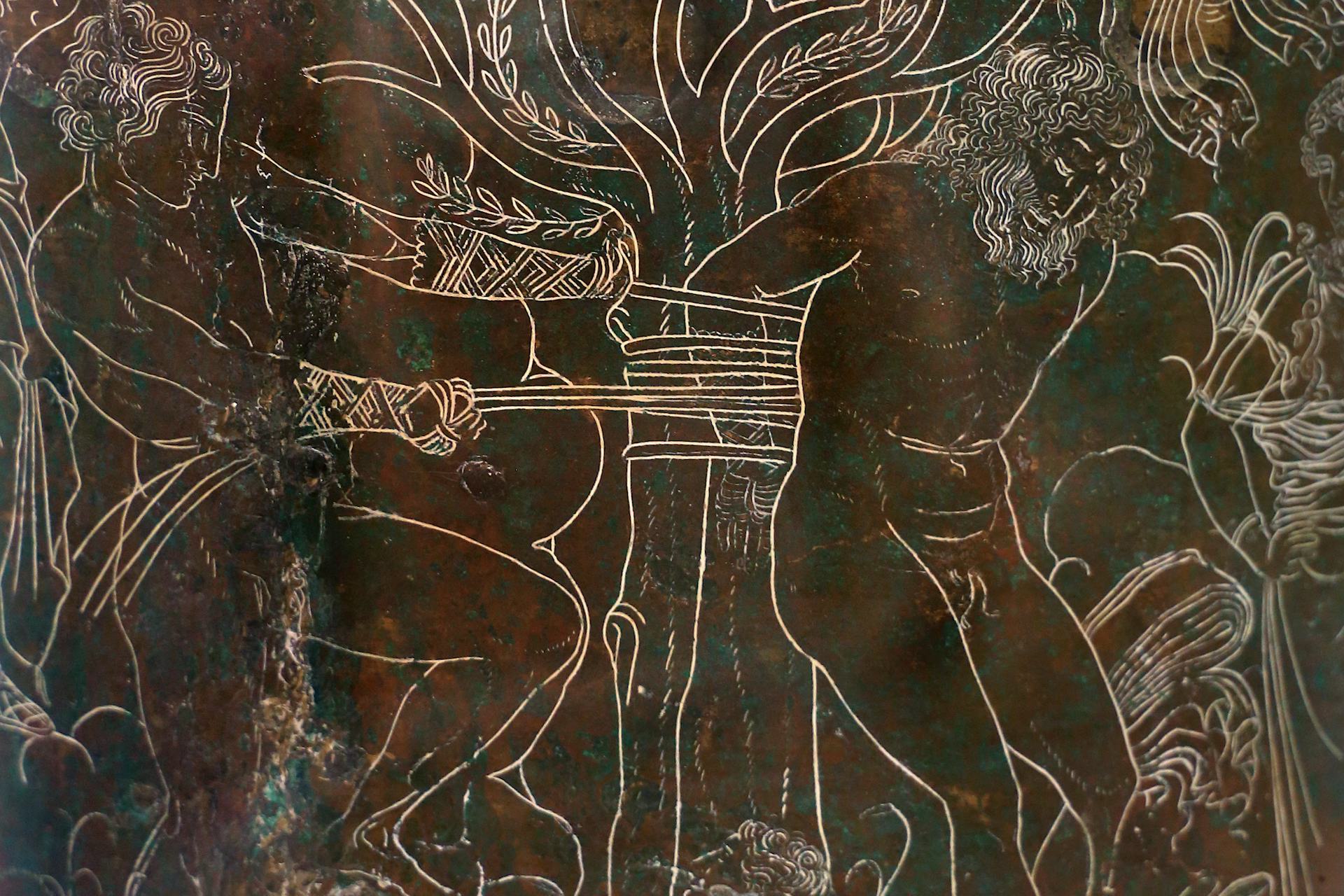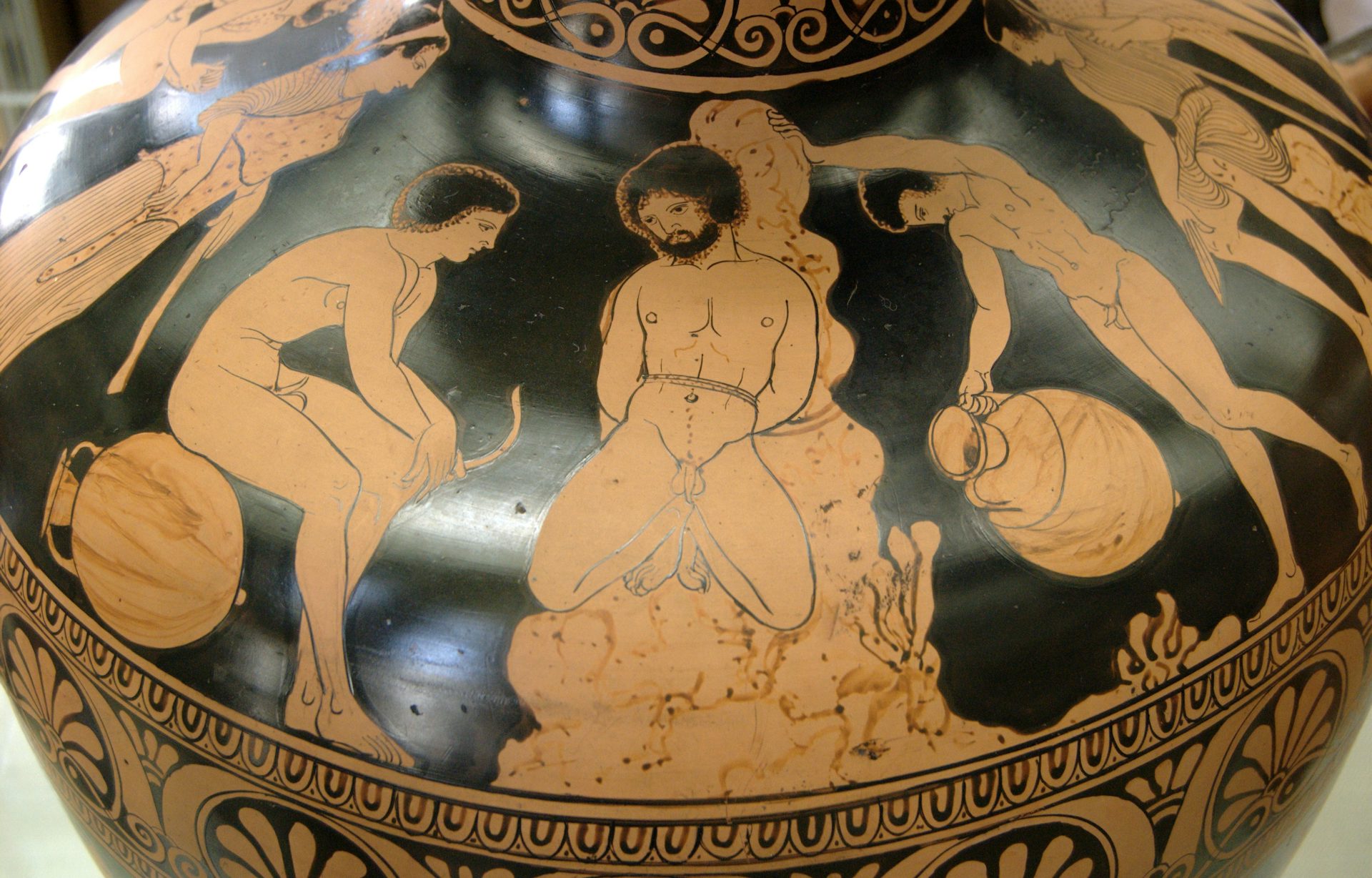Amycus

Detail from the frieze on the Ficoroni Cista showing Pollux (Polydeuces) defeating and binding Amycus (350–330 BC)
National Etruscan Museum, Rome / SailkoCC BY-SA 4.0Overview
Amycus was the son of Poseidon and a nymph. He ruled over the Bebrycians, a warlike people who lived in the region of Bithynia in northern Anatolia. A skilled and innovative boxer, Amycus forced all strangers who came to his shores to fight him.
When the Argonauts stopped at the land of the Bebrycians on their way to fetch the Golden Fleece, Amycus challenged them to a fight (as he always did) and was bested by the Argonaut Polydeuces. In some accounts, Polydeuces killed Amycus; but in others—and in most visual representations of the myth—Polydeuces let Amycus live.
Amycus was later venerated in hero cult in the land he was said to have ruled.
Etymology
The name “Amycus” (Greek Ἄμυκος, translit. Ámykos) may be etymologically related to the verb ἀμύσσω (amýssō), meaning “to wound, mangle”—a reflection of Amycus’ vicious fighting style.
Pronunciation
English
Greek
Amycus Ἄμυκος (Ámykos) Phonetic
IPA
[AM-i-kuhs] /ˈæm ɪ kəs/
Attributes
General
Amycus was a violent and cruel king of the Bebrycians, a mythological race said to have lived in the region of Bithynia in northern Anatolia (part of modern-day Turkey).
Amycus was a skilled boxer and was sometimes credited by the Greeks with the invention of leather boxing gloves.[1] He was typically represented as extremely large, strong, and intimidating. Apollonius of Rhodes wrote that Amycus
seemed to be a monstrous son of baleful Typhoeus or of Earth herself, such as she brought forth aforetime, in her wrath against Zeus…[2]
Amycus was above all arrogant, cruel, and violent, forcing anyone who visited his land to fight him, and usually killing the combatants in the process.
Iconography
In ancient art, Amycus was typically represented as a well-built, muscle-bound fighter, often wearing boxing gloves. Many artists added wild hair and a shaggy beard to accentuate his savagery.
One of Amycus’ most popular scenes was his battle with Polydeuces, which appears on vase paintings, bronzeware, and sculptural reliefs. Interestingly, virtually all of these depictions show the same part of the story, with Polydeuces binding the defeated Amycus to a tree.[3]
Family
Amycus was the son of Poseidon and a Bithynian (or Pelian) nymph; her name was often said to have been Melia.[4] He had a brother named Mygdon, who ruled the Bebrycians after his death and who was eventually slain in battle by Heracles.[5]
In the Aeneid, the Roman poet Virgil mentions a son or descendant of Amycus named Butes, who, like Amycus, was a skilled boxer.[6]
Mythology
Amycus, son of Poseidon, ruled over the Bebrycians, a warlike people from Bithynia on the northern coast of Asia Minor.
Amycus was a strong and skilled boxer who liked to show off his skills in an exceptionally cruel manner: he would challenge all strangers who came to his land to a fight. These matches usually ended with Amycus killing his opponent. Others said that Amycus sacrificed all foreign visitors to his father Poseidon.[7]
Amycus is best known for his role in the story of the Argonauts. While sailing to Colchis in search of the Golden Fleece, the Argonauts stopped at Amycus’ kingdom. Amycus quickly came out to meet them and explained his violent policy surrounding newcomers, challenging one of the Argonauts to face him in the boxing arena.
As luck would have it, one of the Argonauts was Polydeuces, perhaps the most famous boxer of Greek mythology. The Greek hero was more than willing to take on Amycus. Even though Amycus was the bigger man, Polydeuces was more skilled and was soon able to defeat his opponent.
Though all sources agree that Polydeuces defeated Amycus, there are different versions of how their match ended. In most accounts, Polydeuces was said to have killed Amycus.[8] But in a handful of literary accounts, as well as in most visual representations, Polydeuces was shown sparing Amycus’ life, sometimes also binding him to a tree.[9]
According to Theocritus, Polydeuces did no more than force the beaten Amycus to “swear a great oath by the name of his father Poseidon in the sea, that he would nevermore do annoyance unto strangers.”[10]

Illustration of Amycus bound by the Argonauts from a Lucanian red-figure hydria by the Amycus Painter (ca. 425–400 BCE)
Cabinet des Médailles, Paris / Bibi Saint-PolPublic DomainIn some accounts, the Bebrycians were not happy to see their mighty king defeated, and in a rather unsporting turn of events, they attacked Polydeuces and the other Argonauts. A fierce battle broke out, with the Argonauts killing many of the Bebrycians and forcing them to retreat.[11]
Worship
Amycus was worshipped as a hero in Bithynia, where his kingdom was once located. He had a tomb with a laurel tree growing out of it; it was said that anyone who tore a branch from the tree and took it with him aboard a ship would quarrel with his comrades until he threw the branch overboard.[12]
There was also a heroon—that is, a hero shrine—of Amycus, as well as a harbor named after him.[13]